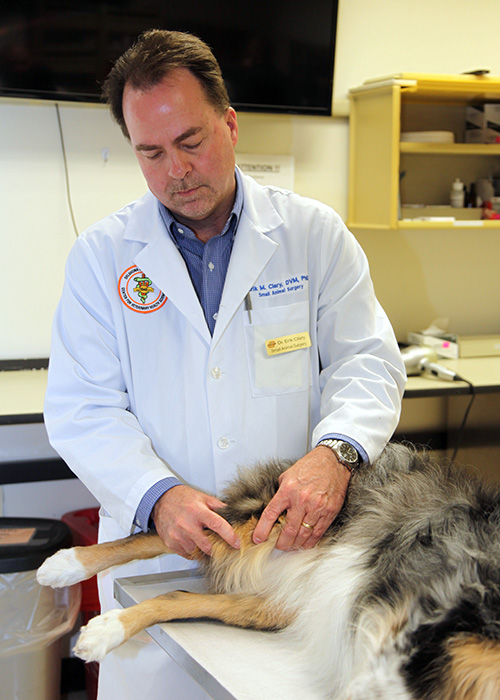
Arthritic joints not just a problem in people
Friday, April 19, 2019
Medical researchers debate the precise mechanism, but the association between cold weather and intensified joint pain is well known to people with degenerative joint disease, or osteoarthritis (OA). And those suffering are many. According to a long-running study conducted by researchers at the University of North Carolina, nearly 50 percent of people aged 45 years or older experience OA-related knee pain, and for people living to the age of 85, one out of four will develop symptomatic OA in one or both hip joints.
Osteoarthritis is not just a problem for people. Indeed, it has been documented in every class of bony vertebrates — mammals, birds, reptiles (dinosaurs included), amphibians and fish. In my work as a small animal orthopedist at Oklahoma State University’s Boren Veterinary Medical Hospital, it is the most common condition I diagnose.
In dogs, OA is almost always secondary — meaning, the result of pre-existing disease. Among the more common causes are hip instability (dysplasia), loose kneecaps, cruciate ligament disease, elbow incongruity and trauma. For reasons not entirely clear, injury to the joint cartilage with these conditions can initiate a vicious cycle wherein damage begets more damage leading to chronic OA.
As with people, clinical evidence of OA in dogs and cats may include enlarged and variably painful joints with diminished range of motion and palpable bone spurs. Other signs include stiffness when rising, sticking a (hurting) leg out when sitting, reluctance to exercise or perform at some previous level (e.g., kitty stops jumping up on the counters), and uncharacteristic aggression when picked up or handled.
While principally degenerative, OA includes an inflammatory component that can flare up on occasion. Stressors promoting flare-ups include excessive activity, concussive exercise, extended periods of inactivity, and, yes, cold weather. Oftentimes, it is the first flare-up that prompts a visit to the veterinarian and the surprise announcement that “your pet has arthritis.”
In the veterinary clinic, the combination of a good history, thorough general and orthopedic exams, and quality radiographs generally suffices to establish the diagnosis of OA. Because OA in dogs (which comprise 90 percent of my orthopedic patients) is usually secondary, and also because an unrelated ailment can sometimes prove to be the primary or even sole cause of dysfunction, the veterinarian may recommend additional tests. These may include blood tests, joint fluid analysis and more advanced imaging (CT, MRI, arthroscopy).
With the diagnosis of OA in hand, the discussion may then turn to treatment options and prognosis. On the downside, pet owners need to be aware that OA is a progressive disease. Medical interventions may mitigate the rate of joint damage but they cannot stop the process completely. On the positive side, many dogs and cats with clinical OA can experience great relief and improved quality of life with appropriate treatment.
In some cases, especially those where joint instability is the major underlying issue (e.g., rupture of the cranial (anterior) cruciate ligament), surgery may be required to alleviate pain and achieve acceptable joint function. In other cases, medical management of OA will be indicated. Standard in that approach is a three-pronged strategy consisting of weight management, activity modification and medications.
The importance of effective weight management in treating OA cannot be overstated. Obesity is very common in small animals and is a major risk factor for clinical OA. Many overweight dogs and cats will experience significant relief of OA-related pain and dysfunction as the excess pounds are shed. Conversely, failure to get the weight under control generally frustrates treatment efforts.
With respect to activity, exercise is critical, but some activities are too hard on arthritic joints. For people dealing with OA, much direction is given to joint-friendly exercises like biking and swimming. Aquatic therapy can be helpful for dogs with OA, but often impractical. Short leash walks on natural terrain are generally recommended. Running around off-leash for extended periods of time, free access to stairs, and spending much time on slick flooring is discouraged.
Of the third treatment prong — medications — the primary focus in dogs has long been non-steroidal anti-inflammatory drugs, or “NSAIDs.” When I entered the veterinary profession, we were mostly limited to using NSAIDs designed for people — chiefly, buffered aspirin. We did so with general unease because toxicity was a real concern. Nowadays, we have in the veterinary arsenal NSAIDs specifically formulated for dogs, but safety concerns remain and thus demand close monitoring and veterinary supervision. In cats, the risk of adverse effects with NSAIDs usage is high enough to warrant extreme caution.
Beyond the traditional three-pronged approach, a multitude of other treatment options have been advocated, some with great passion. Joint injections, acupuncture, fish oils, herbs, glucosamine supplements all have their proponents. Most promising, in my opinion, are treatment strategies emerging within the rapidly developing field of veterinary rehabilitative therapy. Few colleagues conclude in any of the proposed alternatives a replacement for standard therapy. Instead, the innovations might best be considered as a probing for “complementary modalities” (i.e. helpful adjuncts to the three-pronged approach).
COLUMN BY: Erik M. Clary, DVM, PhD, associate professor of surgery and bioethics, Oklahoma State University Center for Veterinary Health Sciences
